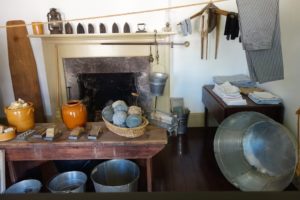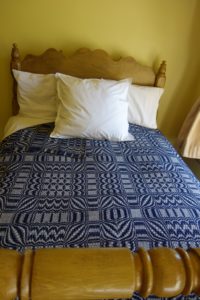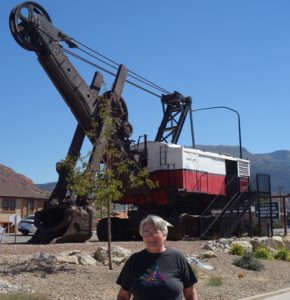I-70 starts in the Social Security Park-and-Ride in Baltimore and ends at I-15 in UT, just one mile beyond Cove Fort. We made it to Cove Fort yesterday. It’s not a bucket list item, but it is a milestone of our trip. The Cove Fort museum is run by the LDS (Latter Day Saints), as the Mormons call themselves. The most important part of the tour was the kitchen, where we saw the coolest stove we have ever seen from the era. With its dual ovens and ability to use coal, it was state of the art. The stove was certainly welcome, as Cove Fort was an important stop for Church leaders as they conducted their business, and an important stop for Mormons migrating west, and also the tithing farm. They prepared 70 to 90 dinners a day. Cove Fort was located to bridge a gap between two other Mormon cities. (Cities were 30 miles apart because that was a good day’s travel, and because that was the limit of the length of a single telegraph line.) The LDS built the Fort because there wasn’t enough water to support a town.
There is no charge to visit Cove Fort. If you arrive, a friendly guide will make themselves available to you immediately, no matter the size of your party. But of course nothing is free. Your guide will be an LDS missionary. Ours was very good at being low key. Here’s a story of life in the late 1800s that was probably true of most people in the West. Ticking is used to make mattresses. When the mattress wears out, better parts of the cloth are used to make pants. When the pants wear out, better parts of the cloth are cut into stripes and stored in balls. The stripes are later used to make rag rugs. When the rugs wear out, what’s left is used to help make soap. Soap is the end of the line for the recycling of the ticking.
If you lived out west, you wanted a warm blanket. Wool is warm, but it’s scratchy and it can be hard to sleep under. That made linsey woolsey blankets popular. The wool made the blanket war,. The linen made it less scratchy.
I also learned that the telegraph used water batteries (which used copper sulfate, copper, zinc, and water). Because the telegraph was limited to 30 miles, a telegraph operator had to receive and re-transmit messages to the next station. Cove Fort had one operator, who was on duty 24×7.
After we finished at Cove Fort, it was a short drive to Cedar City. Our room wasn’t ready when we arrived an hour before check-in time, so we visited a local history museum. Mining was an important industry in the early days of Cedar City. Here is a 1930-era mining shovel. It was powered by a 23,000 volt electric tether and had a 275 hp motor-generator. Moving it to a new site involved using two bulldozers. Amazingly, this shovel was used continuously until 1975. For all its size, the dipper capacity was 6 cubic yards. That’s the size of a large extended cab pickup truck, but it struck me as somewhat small considering the overall size of the machine.
We came back to the hotel an hour after check-in time to find our room still wasn’t ready. We waited another hour beyond that. That’s bad enough, but the hotel had also rented the breakfast area out to some kind of family party. Very excited, very loud kids were running all over the place. We were pretty tired by the time we got to our room. Danita had found a nice restaurant for us, but the information was lost. We took the desk clerk’s recommendation, but the street had two names. We were given one name, the GPS used the other. Once we figured that out, we drove by it before finding it. We were too tired to enjoy dinner. We feel much better after a night’s sleep.
Cedar City has the “Western Look”. Here is a list of some movies made in Cedar City.
Deadwood Coach, staring the popular cowboy Tom Mix – the first movie
The Good Earth
Union Pacific (Cecil B. DeMille, 1939)
Drums Along the Mohawk
Brighham Young
Can’t Help Singing
My Friend Flika
Proud Rebel





